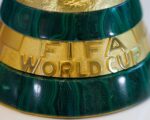On Tuesday, FIFA revealed the method for the draw of the 2026 World Cup scheduled for Dec. 5, detailing the arrangement of the four pots and the sequence in which teams will compete after the draw concludes.
The draw will take place at the Kennedy Center in Washington, D.C., where 48 teams will be divided into four pots to form 12 groups of four teams each. A revised match schedule, allocating each game to specific stadiums with corresponding kick-off times, will be unveiled on Saturday, Dec. 6.
The three host nations will join Pot 1, along with the nine top-ranked nations according to FIFA’s rankings. This group features Spain, Argentina, France, England, Brazil, Portugal, the Netherlands, Belgium, and Germany.
In pot 1, Canada, Mexico, and the United States will use distinct colored balls, with Mexico (green ball) assigned to position A1, Canada (red ball) to B1, and the USA (blue ball) to D1.
The other nine top-seeded teams in pot 1 will be indicated by balls of the same color and will be placed automatically in position 1 of their respective groups.
The subsequent 12 highest-ranked teams will occupy Pot 2.
These consist of Croatia, Morocco, Colombia, Uruguay, Switzerland, Japan, Senegal, Iran, South Korea, Ecuador, Austria, and Australia.
The next group of 12 will occupy Pot 3, which includes Norway, Panama, Egypt, Algeria, Scotland, Paraguay, Tunisia, Ivory Coast, Uzbekistan, Qatar, Saudi Arabia, and South Africa.
The remaining teams will be placed in Pot 4 together with the six victors of the intercontinental playoffs. This pot contains Jordan, Cape Verde, Ghana, Curacao, Haiti, and New Zealand.
The four intercontinental playoff victors will include four UEFA teams and two from other confederations.
The draw will be conducted such that teams from identical confederations cannot occupy the same group, except for Europe, where there are more teams (16) than groups (12).
This results in four groups containing two European teams, with others featuring one from Europe.
In order to maintain balance, top-ranked Spain and second-ranked Argentina will be drawn randomly and placed in different sections of the groups. The same approach applies to the next two highest-ranked teams (France and England), ensuring that if they win their groups, the two top teams will not meet until the final.
The U.S., previously assigned to Group D, will play a Pot 3 opponent in its opening match on June 12 in Inglewood, California. This will be followed by a clash against a Pot 2 team on June 19 at Lumen Field in Seattle, with its final group stage encounter occurring against a Pot 4 team back in Inglewood. For the USMNT, the most challenging game is likely to be the second match with the Pot 2 team.
Similarly, Mexico, which is in Group A, will commence the tournament on June 11 against a Pot 3 team at Estadio Azteca in Mexico City, followed by games against a Pot 2 team on June 18 at Estadio Akron outside Guadalajara and their last group stage contest six days later against a Pot 4 team back in Mexico City
Canada’s schedule will slightly differ. It will begin the tournament on June 12 at BMO Field in Toronto against a Pot 4 team. Its second match will be in Vancouver six days later versus a Pot 3 team, concluding the group stage against a Pot 2 team also in Vancouver.














